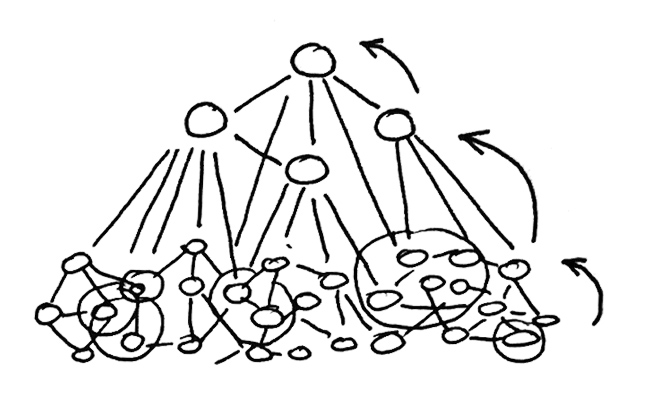18.1. Subsidiarity
Aus Pattern Language Wiki
In developing urban projects, it is important to keep the scale appropriate to the project, and as local and distributed as possible — for example in the Neighborhood Planning Center, and in applying Economies Of Place And Differentiation.
Problem-statement: The best-quality adaptive urbanism occurs at the most locally distributed scale possible.
Discussion: We know from the dynamics of highly-adapted complex systems that they often require adaptive actions at small scales, often at the smallest scale possible. In the political realm, this same idea is known as subsidiarity.
The Oxford English Dictionary defines subsidiarity as “(in politics) the principle that a central authority should have a subsidiary function, performing only those tasks which cannot be performed at a more local level.”1 Wikipedia describes “a principle of social organization that holds that social and political issues should be dealt with at the most immediate (or local) level that is consistent with their resolution.”2 The goal is therefore the decentralization of problem-solving to the most distributed scale that is effective. The concept has been developed within and applied to a number of institutions including the European Union, and is stated as a goal of the New Urban Agenda.
What is at stake is not just a working principle of political decentralization, but the ability to solve problems in the most effective way possible. There are indeed times when this requires a centralized response — for example, in creating large-scale infrastructure systems. But very often, a far more powerful approach is to distribute the problem-solving among many decentralized agents within a “complex adaptive system.” In the case of urban systems, those agents are the various smaller-scale institutions and individuals that carry out so much of the actual creative work of building settlements. This is not, however, a prescription for a solely laissez-faire approach. On the contrary, the role of both the more centralized and the more decentralized units is to work together to establish and maintain cooperative governance structures (see Polycentric Governance, 18.2). This process is dynamic, sometimes messy, but at the same time essential for optimum problem-solving and adaptive quality.
This is not, however, a prescription for a solely laissez-faire approach. On the contrary, the role of both the more centralized and the more decentralized units is to work together to establish and maintain cooperative governance structures (see Polycentric Governance, 18.2). This process is dynamic, sometimes messy, but at the same time essential for optimum problem-solving and adaptive quality.
This approach must also be mindful of the pursuit of justice in human affairs. Subsidiarity must not be a license to deprive people of a just opportunity for access to resources and quality of life. In such a case, by definition, the resolution of the injustice must occur on a more centralized scale.
Finally, it is critical to provide mechanisms for monitoring at the smallest scales, to ensure that they actually produce results — not in order to suppress local actions “from above”, but instead to provide resources as needed to improve results, using Polycentric Governance.
Therefore:
Do not centralize decision-making and problem-solving too much in cities and towns — but do not decentralize them too much either. Instead, aim for the distribution of tasks to the smallest possible scale that will be effective in resolving them. Refine and adjust the scales based on results.
Structure subsidiary institutions according to Polycentric Governance. Use Public-Private Place Management carefully, without allowing local problem-solving to become too centralized within either public or private entities. …
¹ See https://en.oxforddictionaries.com/definition/subsidiarity.
Mehaffy, M. et al. (2020). SUBSIDIARITY (pattern). In A New Pattern Language for Growing Regions. The Dalles: Sustasis Press. Available at https://pattern-language.wiki/.../Subsidiarity
SECTION I:
PATTERNS OF SCALE
1. REGIONAL PATTERNS
Define the large-scale spatial organization…
1.4. 400M THROUGH STREET NETWORK
2. URBAN PATTERNS
Establish essential urban characteristics…
3. STREET PATTERNS
Identify and allocate street types…
4. NEIGHBORHOOD PATTERNS
Define neighborhood-scale elements…
5. SPECIAL USE PATTERNS
Integrate unique urban elements with care…
6. PUBLIC SPACE PATTERNS
Establish the character of the crucial public realm…
7. BLOCK AND PLOT PATTERNS
Lay out the detailed structure of property lines…
8. STREETSCAPE PATTERNS
Configure the street as a welcoming place…
9. BUILDING PATTERNS
Lay out appropriate urban buildings…
10. BUILDING EDGE PATTERNS
Create interior and exterior connectivity…
10.1. INDOOR-OUTDOOR AMBIGUITY
SECTION II:
PATTERNS OF MULTIPLE SCALE
11. GEOMETRIC PATTERNS
Build in coherent geometries at all scales…
11.2. SMALL GROUPS OF ELEMENTS
12. AFFORDANCE PATTERNS
Build in user capacity to shape the environment…
13. RETROFIT PATTERNS
Revitalize and improve existing urban assets …
14. INFORMAL GROWTH PATTERNS
Accommodate “bottom-up” urban growth…
15. CONSTRUCTION PATTERNS
Use the building process to enrich the result…
SECTION III:
PATTERNS OF PROCESS
16. IMPLEMENTATION TOOL PATTERNS
Use tools to achieve successful results…
16.2. ENTITLEMENT STREAMLINING
16.3. NEIGHBORHOOD PLANNING CENTER
17. PROJECT ECONOMICS PATTERNS
Create flows of money that support urban quality…
17.4. ECONOMIES OF PLACE AND DIFFERENTIATION
18. PLACE GOVERNANCE PATTERNS
Processes for making and managing places…
18.3. PUBLIC-PRIVATE PLACE MANAGEMENT
19. AFFORDABILITY PATTERNS
Build in affordability for all incomes…
19.1. INTEGRATED AFFORDABILITY
20. NEW TECHNOLOGY PATTERNS
Integrate new systems without damaging old ones…
20.2. RESPONSIVE TRANSPORTATION NETWORK COMPANY

